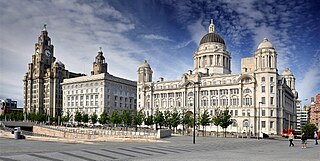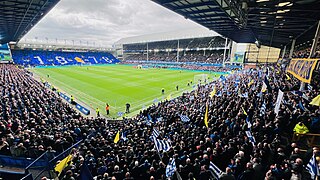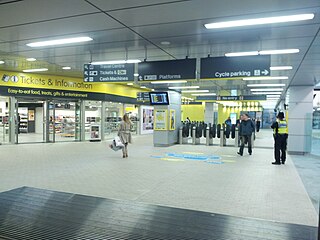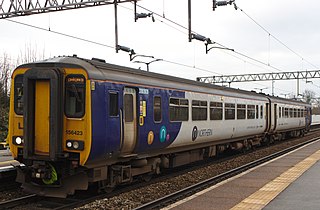
Liverpool is a city and metropolitan borough in Merseyside, northwest England. It had a population of 486,100 in 2021. The city is located on the eastern side of the Mersey Estuary, adjacent to the Irish Sea, and is approximately 178 miles (286 km) from London. Liverpool is the fifth largest city in the United Kingdom, and the largest settlement in Merseyside. The city forms part of a larger urban region of over 2 million people which extends into the neighbouring counties of Cheshire and Lancashire. Liverpool is part of the Liverpool City Region, a combined authority with a population of over 1.5 million.

Liverpool Street station, also known as London Liverpool Street, is a major central London railway terminus and connected London Underground station in the north-eastern corner of the City of London, in the ward of Bishopsgate Without. It is the terminus of the West Anglia Main Line to Cambridge, the Great Eastern Main Line to Norwich, commuter trains serving east London and destinations in the East of England, and the Stansted Express service to Stansted Airport.

Merseyside is a ceremonial and metropolitan county in North West England. It borders Lancashire to the north, Greater Manchester to the east, Cheshire to the south, the Welsh county of Flintshire across the Dee Estuary to the southwest, and the Irish Sea to the west. The largest settlement is the city of Liverpool.

Liverpool is a suburb of South Western Sydney, in the state of New South Wales, Australia. It is located approximately 31 kilometres (19 mi) south-west of the Sydney CBD. Liverpool is the administrative seat of the local government area of the City of Liverpool and is situated in the Cumberland Plain.

Liverpool Lime Street is a terminus railway station and the main station serving the city centre of Liverpool. Opened in August 1836, it is the oldest still-operating grand terminus mainline station in the world. A branch of the West Coast Main Line from London Euston terminates at the station, as does the original Liverpool and Manchester Railway. Journeys from Lime Street cover a wide range of destinations across England, Scotland and Wales.

Merseyrail is a commuter rail network which serves Merseyside and adjacent areas of Cheshire and Lancashire. Merseyrail serves 69 stations, 67 of which it manages, across two lines – the Northern Line and the Wirral Line. The network uses 750 V DC third rail electrified lines having 75.0 miles (120.7 km) of routes, of which 6.5 miles (10.5 km) are underground. Since January 2023, Merseyrail commenced replacing its train fleet, withdrawing the Class 507 and 508 trains and introducing 53 new Class 777 trains. The network carried 25.5 million passengers in the 2022/2023 statistical period.

Goodison Park is a football stadium in the Walton area of Liverpool, England, 2 miles (3 km) north of the city centre. It has been the home of Premier League club Everton since 1892 and has an all-seated capacity of 39,414.

Everton is a district of north Liverpool, England, and part of the Liverpool Walton constituency. It is bordered by Vauxhall to the west, Kirkdale to the north, and Anfield to the north-east. Historically in Lancashire, at the 2011 Census the population was 14,782.

Dingle is an inner city area of Liverpool, Merseyside, England. It is located to the south of the city, bordered by the adjoining districts of Toxteth and Aigburth. At the 2001 Census, the population was recorded at 13,246.

Liverpool Central railway station in Liverpool, England, forms a central hub of the Merseyrail network, being on both the Northern Line and the Wirral Line. The station is located underground on two levels, below the site of a former mainline terminus. It is the busiest station in Liverpool, though considerably smaller than Lime Street station, the mainline terminus, and the busiest station to operate solely on the Merseyrail network. The station is the busiest underground station outside London serving 40,000 people daily. The station in passengers per platform is the busiest underground railway station in the United Kingdom at 5,217,547 per platform per annum and laying third in all stations, underground or overground.

Liverpool ONE is a shopping, residential, and leisure complex in Liverpool, England. The project involved the redevelopment of 42 acres of land in the city centre. It is a retail-led development anchored by the department store John Lewis. Debenhams had previously been an anchor tenant until the closure of its Liverpool One store in March 2021, with Marks & Spencer taking its place in mid-2023. Additional elements include leisure facilities, apartments, offices, public open spaces, restaurants, and transport improvements. The completion of Liverpool ONE significantly boosted the local economy, while lifting Liverpool into the top five most popular retail destinations in the UK.

Liverpool James Street is a railway station located in the centre of Liverpool, England; it is situated on the Wirral Line of the Merseyrail network. James Street is an underground station, with access to the platforms via lifts from the booking hall. At certain times, the platforms are accessed via a pedestrian tunnel from the India Buildings on Water Street. As of 2013/14, James Street was the fifth-busiest station on the Merseyrail network.

Hunts Cross railway station is a Grade II listed railway station in Hunt's Cross, Liverpool, England. It is situated on the southern branch of the City Line (Merseytravel)'s Liverpool to Manchester Line route, and is the southern terminus of Merseyrail's Northern Line.

There once were four direct railway routes between Liverpool and Manchester in the North West of England; only two remain, the two centre routes of the four. The most northerly and the most southerly of the four routes are no longer direct lines. Of the remaining two direct routes, the northern route of the two is fully electric, while the now southern route is a diesel-only line. The most northerly of the four has been split into two routes: the western section operated by Merseyrail electric trains and the eastern section by diesel trains, requiring passengers to change trains between the two cities. The fourth route, the most southerly of the four, has been largely abandoned east of Warrington; the remaining section caters mainly for freight trains.

Liverpool South Parkway station is a railway station and bus interchange in the Garston district of Liverpool, England. It serves, via a bus link, Liverpool John Lennon Airport in the neighbouring suburb of Speke, as well as providing an interchange between main line services and the Merseyrail rapid transit/commuter rail network. Opened in 2006 on the site of the former Allerton railway station, it also replaced the nearby Garston station.
The Liverpool–Parramatta T-way is a continuous series of bus-only lanes and bus roadways between Parramatta and Liverpool in Western Sydney. Completed in February 2003, the 31 km (19.3 mi) T-way was the first bus rapid transit infrastructure to be built in Sydney.

The Pride Quarter, also known as the Stanley Street Quarter, Liverpool Gay Quarter or Village, is an area within Liverpool City Centre, England. It serves as the main focal point for Liverpool's lesbian, gay, bisexual and transgender community. The quarter is made up of mixed use developments including residential blocks, hotels, bars, nightclubs and various other businesses, many of which cater for the LGBT community. Aspects of the annual Liverpool Pride are also held in and around Stanley Street.

Liverpool city centre is the commercial, cultural, financial and historical centre of Liverpool and the Liverpool City Region, England. Different definitions of the city centre exist for urban planning and local government, however, the border of Liverpool city centre is broadly marked by the inner city districts of Vauxhall, Everton, Edge Hill, Kensington and Toxteth.
Elections to Liverpool Town Council were held on Saturday 26 December 1835.
Elections to Liverpool Town Council were held on Wednesday 1 November 1843. One third of the council seats were up for election, the term of office of each councillor being three years.


















